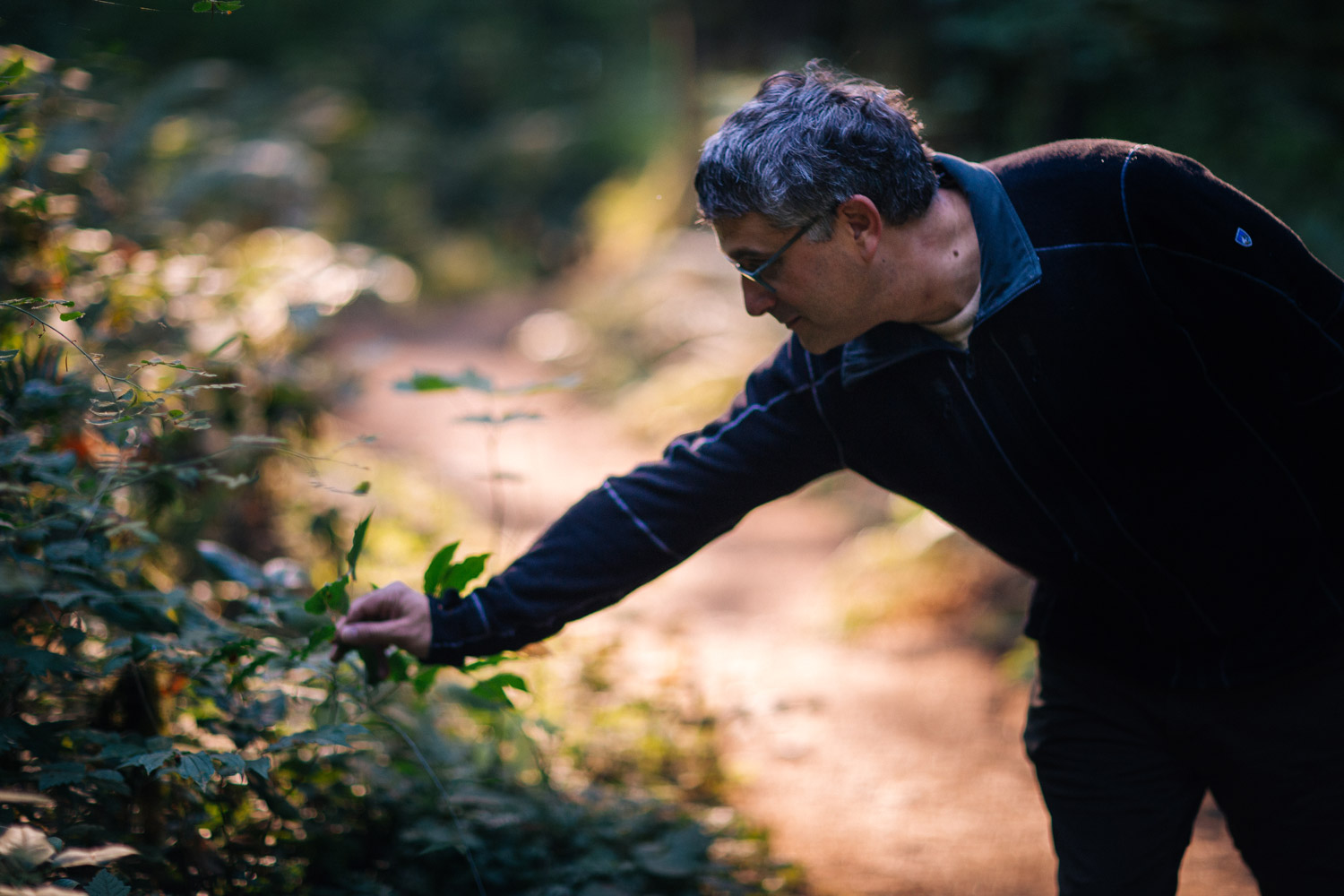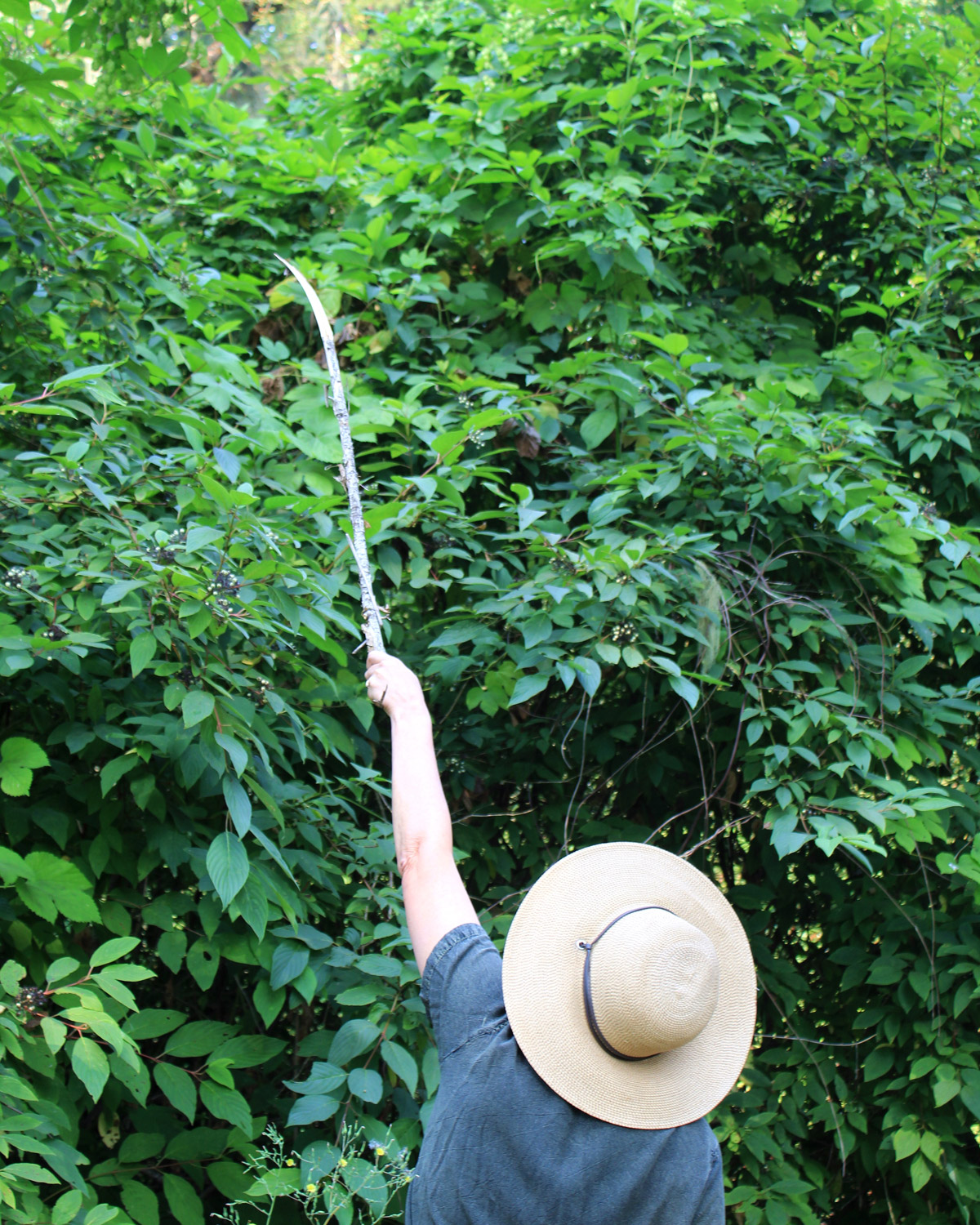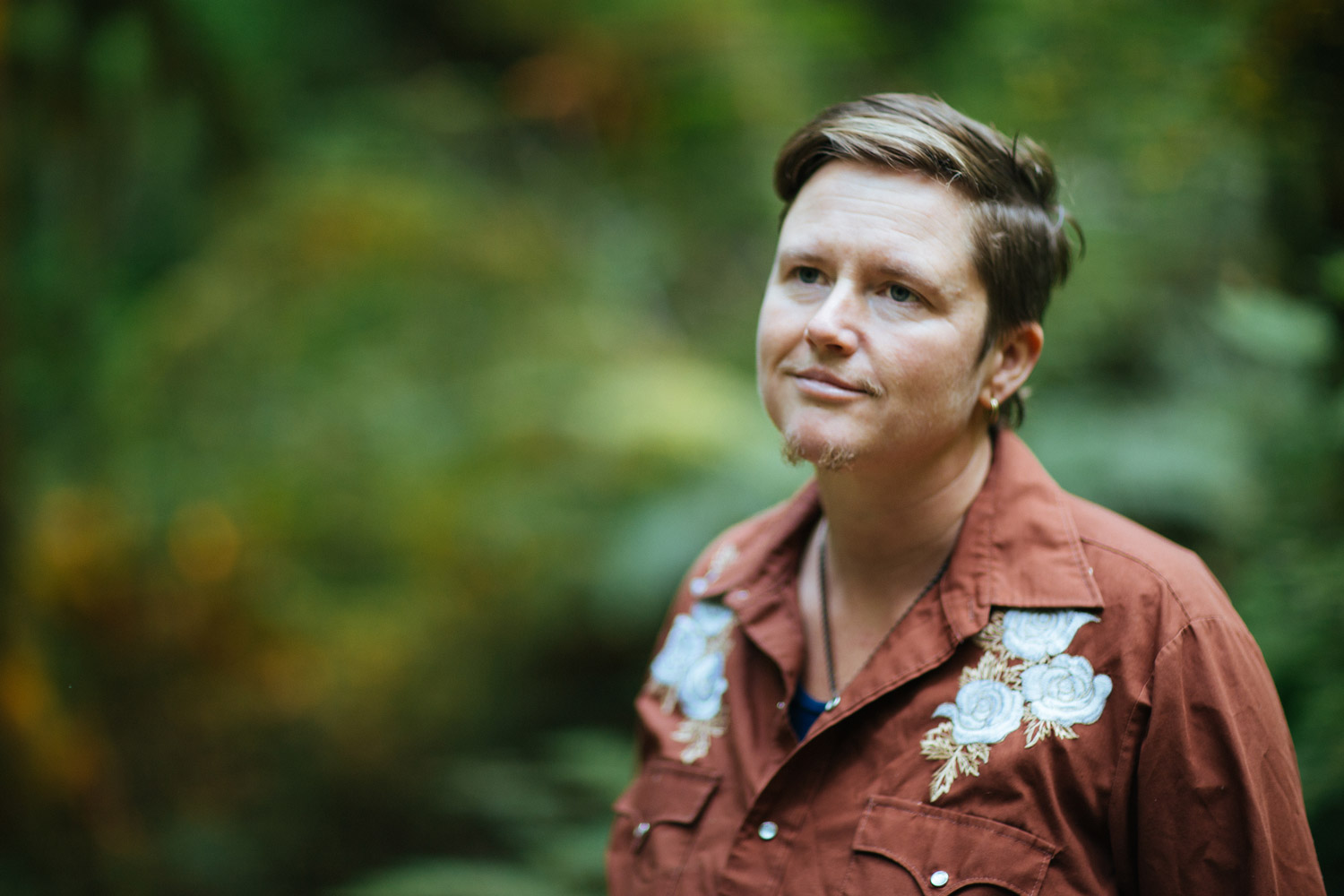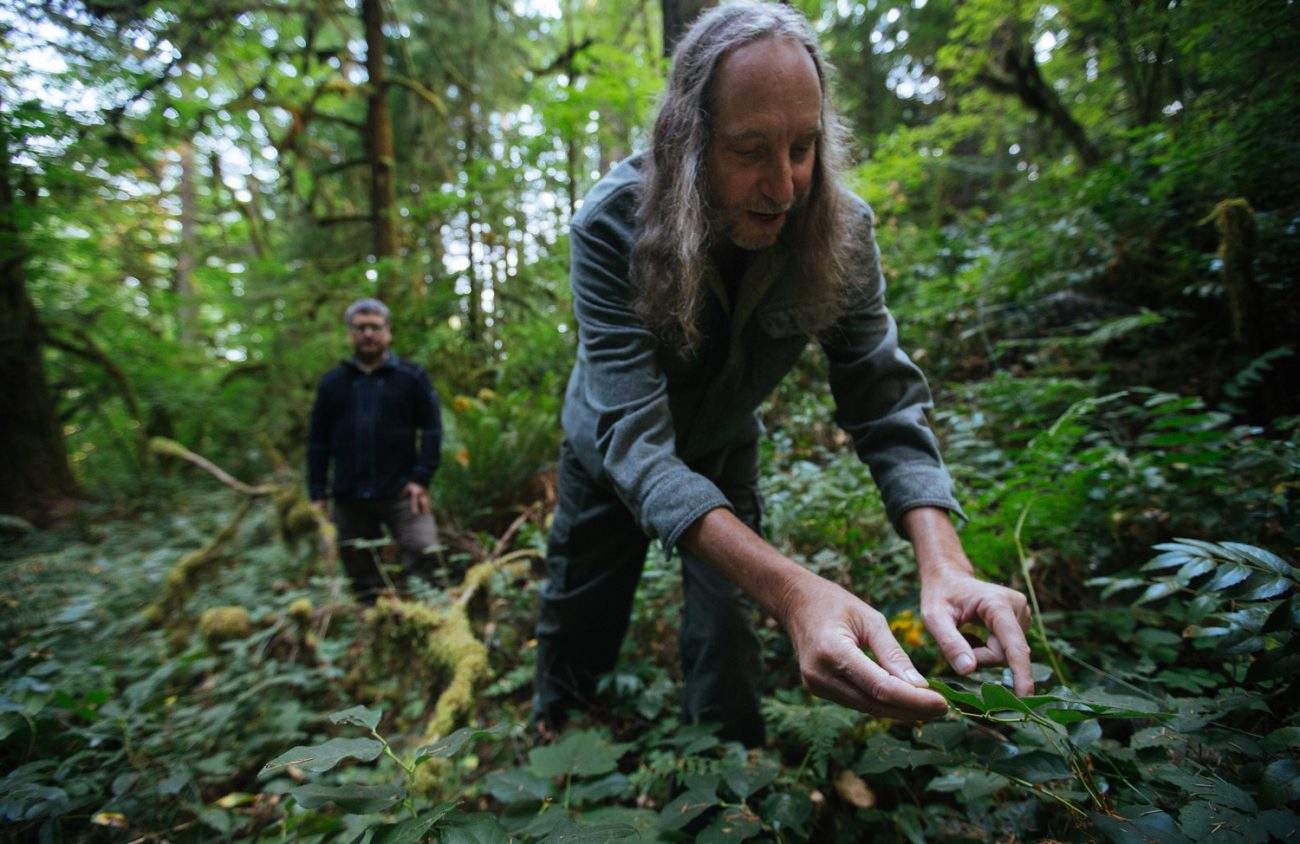Sue Sierralupe stands on the trail, looking into the creek-side trees and brush. “Poor man’s opium,” she says, pointing into the brambles at some wild lettuce (Lactuca serriola). Sierralupe explains that the lactucarium, the latex or sap of the plant, can help with pain.
As herb team leader and clinic manager of the free all-volunteer Occupy Medical, Sierralupe says the plant is sometimes given to homeless patients who might be targeted for attacks if given prescription painkillers. Wild lettuce is not related to opium, but for those on the street, whose painkilling drugs might be stolen and sold, the plant is a valuable alternative.
It’s the cool start to what will soon be a hot, smoky August day, and Sierralupe is walking through Elijah Bristow State Park, about 20 miles outside Eugene, pointing to native and non-native plants and trees. It’s a park I’ve been to hundreds of times, though with scant knowledge of what’s actually going on in the greenery around me beyond an appreciation for the sweet taste of late summer blackberries.
Walking with an herbalist and wildcrafter brings a whole new perspective on what is otherwise a mass of green and yellow vegetation. Leaves have names and flowers have uses — even non-native weeds have their place for an herbalist.
Wildcrafters harvest plants for use in medicines and supplements as well as foods. And picking the plants is only the beginning. Wildcrafting is not just identifying and harvesting the plants but also focusing on the botany, ecology, uses and relationships to the places the plants are found.
From small herbal shops to nationally known herbal schools and the herb giant Mountain Rose, Lane County is home to those who love, use — and sometimes overuse — the plants around us.
It’s another summer morning, earlier in the month, and I’m knocking on the door of a quaint house on 5th Avenue near the highway bridges not far from downtown Eugene. Mrs. Thompson’s Herbs Gifts & Folklore looks like it should be in an old neighborhood on a hill somewhere, not nestled between boxy businesses.
It’s before business hours, and as Heather Níc an Fhleisdeir opens the door to let me in, it feels as though I’ve left Oregon, gone back a hundred years and landed in a Scottish town. The wooden floors, the shelves full of jars of herbs and tinctures, the Celtic symbols and the herb garden outside — all give this apothecary the aura of a shop from another time.
Níc an Fhleisdeir came to herbalism and wildcrafting while working as a part-time interpretive guide for the National Park Service, teaching trailside botany in the Santa Monica Mountains. “Knowledge for folly,” she says of this time. Although she could tell people all about these plants, they were protected and couldn’t be picked and used.
Fast-forward 25 years or so, and Níc an Fhleisdeir is trained as an herbalist and runs the Academy of Scottish Herbalism. The tie to Scotland is not simply a piece of Níc an Fhleisdeir’s Celtic heritage, or because the academy was originally founded in Scotland in 2000. It’s also because, as Níc an Fhleisdeir tells it, she refuses to teach what she has learned about indigenous plants used by Native Americans. She can, however, “tell you about European invasive plants.”
Like other ethical wildcrafters, Níc an Fhleisdeir is sensitive to the ecology surrounding the plants. And certain native plants, as well as those historically used by Native peoples, are “no pick” in Oregon, either because they’ve been devastated by picking or they might be if the plants became popular. Trillium (Trillium ovatum) is a classic example.
According to the group United Plant Savers, trillium is an “at-risk” plant; it is listed as endangered, and threatened or vulnerable in several states. It’s not at-risk in Oregon, but ethical herbalists have deemed it a “no-pick” as a protective measure. United Plant Savers says on its website that there is “rich folklore” about trillium “as a love potion, which makes sense for the passion it elicits in plant lovers.”
“All of the plants our ancestors brought here from the British Isles are now invasive plants,” Níc an Fhleisdeir says. And “wild harvesting is birth control” for invasives.
Níc an Fhleisdeir uses the example of blackberries. While Oregon has a native species of trailing blackberry (Rubus ursinus), what you tend to see growing wild around town and forests, or wherever humans have disturbed the land, is non-native Himalayan blackberries (R. procerus, and actually from Germany not the Himalayas) or, occasionally, another invasive British species (R. laciniatus).
The roots, boiled in water, can help stop diarrhea, she explains. The leaves make a tea that rivals black tea, minus caffeine but with the benefit, she says, of strengthening the muscles. And as a “lowly cousin” of the raspberry leaf, blackberry leaves have uses as a reproductive tonic. The flowers can be eaten — and a benefit of using roots and flowers is that birth control she mentioned — keeping the plant in check. The berries themselves, aside from being nutritive with flavonoids and antioxidant functions, can also help with constipation (the opposite of the root’s use), she says.
Níc an Fhleisdeir also advocates the use of dandelions (Taraxacum officinale). “We don’t need herbs ground and shipped from China,” she says.
The roots of the ordinary dandelion weed, which came to the U.S. from Europe, protect and cleanse the liver, she says. The leaves, which can be eaten in salads, are good for digestion and, she adds, eating dandelion will unlock nutrients in other plants.
Wildcrafting for dandelions and blackberries benefits landowners who don’t want the prickles and weeds in their fields, so Níc an Fhleisdeir suggests getting permission from private property owners (those who haven’t doused the plants with herbicides) to come onto their property and harvest. She cautions potential pickers to do their research in advance: Know what you plan to make with the plant, have your supplies ready and don’t harvest more than you can use.
That idea of not harvesting more than you can use — or the Earth can supply — is echoed down West 11th Avenue where, after driving down the busy road, I pull into the parking lot of Mountain Rose Herbs. While I have heard Mountain Rose disparagingly called “the Walmart of herbs,” the disparagement seems only accurate in the sense that while most herbalists in the area are small scale, Mountain Rose is vast.
Enlarge

Jennifer Gerrity, executive director of operations, sits down at a wooden table in Mountain Rose’s airy offices with Steven Yeager, the company’s director of quality control and assurance. Yeager is also on the board of United Plant Savers as well as an instructor at the Columbines School of Botanical Studies.
Gerrity says Mountain Rose uses a combination of wild harvested herbs and cultivated herbs. In the case of wildcrafting, Gerrity says, how much Mountain Rose buys and then sells is not determined by customer demand but by conservation aspects.
They give the example of ginseng, a plant often found growing together with goldenseal. Ginseng has long been used in Asia for its healing properties. American ginseng (Panax quinquefolius) is dug up, poached and exported, to the degree that it is listed in the Convention on International Trade in Endangered Species of Wild Fauna and Flora (CITES) treaty, which seeks to ensure that “international trade in plants and animals does not threaten their survival in the wild,” according to the U.S. Fish and Wildlife Service.
Goldenseal (Hydrastis canadensis) is also listed.
As such, wild and wild-simulated American ginseng roots can only be legally exported if they were harvested from plants five years of age or older, and were legally harvested during the designated state harvest season, USFWS says. Goldenseal and ginseng require a CITES permit or certificate before export. Finished products of both plants don’t require permits to export.
So, Gerrity says, Mountain Rose uses a Forest Grown Verification program that provides a third-party audit system for native medicinal plants grown in their natural habitat in hopes of developing a more sustainable industry these plants.
“For plants like ginseng, people have looked at money instead of conservation,” Yeager says.
Gerrity says wildcrafting is both an art and a science, and often uses knowledge that has been handed down for generations. It’s a lineage skill, she says. “Species, harvest times, ecosystems; there’s a lot that goes into it,” she says, adding that the company seeks to support that cottage economy in communities across the U.S. and internationally.
For wildcrafted herbs, the company has wildcrafters sign an affidavit that addresses ecological sensitivity, percentage of take, where the plants were harvested, permitting and more. Mountain Rose also goes out on site visits, or “boots on the ground,” as Yeager puts it, to see farms and wildcrafted stands.
Mountain Rose sells its herbs as supplements. Herbal supplements and botanicals are considered dietary supplements and not regulated by the Food and Drug Administration in the same way as foods and medicines. This means that while companies still need to meet quality control standards, they don’t have to test the products the way a new pharmaceutical must be tested.
Thus Mountain Rose is careful in how it discusses its herbs and their properties. “The active constituents of goldenseal,” says the company’s website, “have proven to in vitro to show antimicrobial activity, but human data is currently lacking.”
Yet consumers turn in droves to its herbal remedies for healing as well as its spices and other products, giving Mountain Rose a thriving business at its mercantile east of Mrs. Thompson’s on 5th Avenue, as well as at its corporate offices and online. Mountain Rose is easily an herbal green giant. The business is privately owned and doesn’t disclose its annual financial figures, but take a look at the more than 5,000 products it sells on its website and the “more than $189,000 in cash sponsorships and more than $35,700 of in-kind support to nonprofits, free clinics and herbal schools across the U.S.” it lists in its 2016 sustainability report.
Enlarge

When you talk about wildcrafting and herbs in Eugene, Mountain Rose’s name inevitably comes up — people make pilgrimages to Mountain Rose the way some coffee lovers visit the first-ever Starbucks in Seattle’s Pike Place Market. But those in the know also unfailingly bring up Howie Brounstein and the Columbines School of Botanical Studies.
Brounstein, tall and lanky with shoulder-length hair, holding his coffee in a Mason jar, might look more like the stereotype of an herbalist than Yeager with his short dark hair, glasses and fleece jacket, but the two tell me they have worked together for a good 20 years. Brounstein jokingly calls Mountain Rose Yeager’s “night job.”
Brounstein has been wildcrafting and teaching herbalism for about 30 years. He and Yeager met while Brounstein was selling his products as Columbines & Wizardry Herbs.
Enlarge

Together with Heron Brae, the three are the instructors for Columbines’ well-respected education program that runs from entry-level lectures in community herbalism to a three-year program that they say includes “botany, ecology, wildcrafting, plant pharmacy, physiology, pathophysiology and clinical herbalism.”
We head out for a brief walk in the woods at Hardesty Mountain, east of Eugene. Normally, Brounstein explains, Columbines takes its students out the McKenzie, and that is where it has its permits from the Forest Service to harvest.
A tenet for wildcrafters is to not collect without permission. On my earlier walk, Sierralupe laughingly pointed to the fairy tale of Rapunzel, which starts with Rapunzul’s father stealing rampion from a witch’s garden, as “wildcrafting gone wrong.”
Today we are just looking and perhaps snacking on a plant or two, or at least the Columbines instructors eat some wood sorrel (Oxalis oregana) while I look for something I can recognize, like a blackberry. This spot, farther from town than Elijah Bristow, gets less use, and so Yeager explains that while there are some invasives near the well-used parking lot, further in we are looking at only native plants.
Brae tells me she teaches the wild-food tending component of the school’s third-year course. Some people call it wildcrafting when out harvesting wild plants for food, while others consider it foraging, Brae says, adding that sometimes medicinal and food uses can overlap. For instance, the tart berries of the Oregon grape (Berberis nervosa or Mahonia nervosa or aquifolium) are edible, while the roots are harvested for medicinal purposes.
Brae explains that “wild foods are more nutritionally dense, which means you eat less of them” to feel full. The soil in the wild has fewer nutrients leached out than the farmed soils in which plants are harvested year after year.
The three Columbines instructors bring their students back to the same plots year after year, Brounstein explains, and then requires that those students develop their own plots and not return to the ones the school uses. This lets the wildcrafters see the effects of their harvest over time. It’s about the relationship with the place, Yeager says.
Brounstein cautions against “herb lust” — when someone gets excited and picks more than they can use. Soon a patch is depleted, but the wildcrafter can’t even begin to process what was gathered and the plant goes to waste, as well as having a reduced presence in the wild.
Some plots have been killed by overpicking, Brounstein says. And he recommends that, when harvesting from a stand, pickers adhere to a 1-in-10 ratio leaving enough plants behind to continue reproducing in the wild and for the wildlife. He rarely harvests more than one percent of a stand, he says.
Brounstein recommends beginners harvest plants like blackberries and dandelions — the same invasives Níc an Fhleisdeir suggests — because they are not easily damaged or eliminated. Yarrow (Achillea millefolium) is another example of a hard-to-kill yet useful plant.
Looking at Brounstein’s checklist for wildcrafting, I wonder if “herb lust” is related to his directive to have a “proper emotional state” when wildcrafting. It’s not hippie-dippie, he assures me.
Just as a rock climber should be in the right state of mind before a climb, a wildcrafter can do harm, or do themselves harm, by not being in the right state of mind. You might misidentify a plant, not find what you are looking for, or get so excited when you do find what you were looking for that you don’t step back and realize there’s a better stand nearby, or you might not pay attention to what you are doing, fall and get hurt.
Oregon grape is a plant the Brounstein uses often in his teaching. Its spiny leaves and purple berries are native, abundant and useful. “Howie has done a lot to popularize it,” Brae says.
And Brounstein cheerfully admits there might be as much as six hours of lecture on the plant, from how to identify it, to how to harvest it, protect its ecosystem, process it and use it.
Oregon grape root has antimicrobial qualities, he explains. And the plant that has properties that can replace those of plants that have been overharvested. Both goldenseal and Oregon grape’s rhizome (underground stem) contains bright-yellow berberine, which recent studies have shown to enhance the effects of antibiotics used against drug-resistant MRSA.
Brountstein extolls Oregon grape root’s uses: a salve for infections, a medicine for internal infections, a bitter (a digestive stimulant), a liver stimulant, and helpful for colds and flus.
There are many schools of thought when it comes to wildcrafting and herbalism — some try to emulate Native American plant uses, while others like Níc an Fhleisdeir focus on European plants and invasives, and yet others, like Brounstein and the Columbines School, build on years of plant studies. There are also those who believe the plants can “tell” them their uses. But despite the variety of beliefs and practices, the efforts to preserve the ecosystem, to use the plants ethically and to use them to help heal come up again and again.
For Sierralupe, the herbals offer the unhoused and others in need that she works with at Occupy Medical a viable alternative to pharmaceuticals that may be problematic for them. Like Brounstein, she is a proponent of Oregon grape — good for sinus infections, she tells me.
On our summer morning walk we were looking for yarrow, but she notes for next year that we’ve come to Bristow too late in the season. Yarrow has azulene in it, which is a potent anti-inflammatory compound, she says. The plant is astringent and works great for wounds.
As we wander through the park, she carries her basket with a cloth to cover the plants, pruners and scissors for harvesting and containers for what she picks, among other things. She points to plant after plant, which look ordinary but are extraordinary in their usefulness: oak leaves can be used to make a soothing “snotlike” salve for stings, St. John’s wort can be used for those with PTSD, birch can make a footbath to help those with diabetic ulcers, lemon balm helps with anxiety.
She echoes Brounstein’s admonishment that wildcrafting is more than just the plant’s uses. It’s preserving its ecosystem; it’s being ethical.
Wildcrafting is stewardship, Brounstein repeats. “It’s not a one-night stand.”
Wildcrafting Checklist
Do you have the permission or the permits for collecting at the site?
Do you have a positive identification?
Are there better stands nearby? Is the stand big enough?
Are you at the proper elevation?
Is the stand away from roads and trails?
Is the stand healthy?
Is there any chemical contamination?
Is there any natural contamination?
Are you in a fragile environment?
Are there rare, threatened, endangered, or sensitive plants growing nearby at any time of the year?
Is wildlife foraging the stand?
Is the stand growing, shrinking, or staying the same size?
Is the plant an annual or a perennial?
Is tending necessary and what kind?
How much to pick?
Time of day? Time of year?
What effect will your harvest have on the stand?
Do you have the proper emotional state?
Move around during harvesting.
Look around after harvesting. Any holes or cleanup needed?
Are you picking herbs in the proper order for a long trip?
Are you cleaning herbs in the field?
Do you have the proper equipment for in-field processing?
Wildcrafting is Stewardship ©1995HB this material may be reproduced as long as it remains unchanged and complete with this copyright attached.
